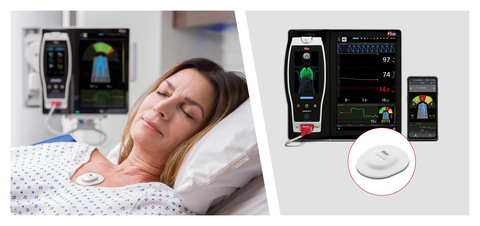PHILADELPHIA– Masimo (NASDAQ: MASI) and Temple Health today announced that Temple University Hospital (TUH), a 722-bed academic medical center located in Philadelphia, is expanding its use of Masimo technologies with Centroid™, an advanced wireless patient position, orientation, activity, and respiration rate sensor, at 100 beds across its ICU units.
Centroid helps clinicians monitor patient position to avoid preventable pressure injuries, and can alert clinicians to sudden movements such as fall-like events. In addition, Centroid detects chest movements to continuously provide respiration rate, assisting clinicians with additional data that may inform care decisions. Centroid pairs with the Root® Patient Monitoring and Connectivity Platform using Bluetooth® to track a patient’s posture, orientation, and activity, providing the ability to monitor patient position and detect changes in position. The data transmitted by Centroid can be displayed in various formats on Root, giving clinicians multiple ways to assess adherence to protocols regarding tissue stress and to tailor care to the specific needs of each patient. In addition, Centroid data can be relayed via the Masimo Hospital Automation™ platform to Patient SafetyNet™, Masimo’s centralized remote patient supplemental monitoring platform, and Replica®, a mobile application that allows clinicians to view continuous data regardless of location.
At TUH, all ICU beds are being equipped with Root and with Centroid, including the Trauma ICU, Cardiothoracic ICU, Burn ICU, Neurological ICU, and Medical Respiratory ICU. Angelo Venditti, DNP, RN, Executive Vice President for Patient Care and Chief Nursing Executive at Temple Health, said, “We are pleased to expand our relationship with Masimo, which has already proven itself as a key technology partner in our efforts to improve patient outcomes. When we trialed Centroid, we found it helped our teams prioritize workflows more effectively, with increased focus on following turn protocols and decreased incidence of pressure injuries.”
Hospital-acquired pressure injuries (HAPI), commonly known as bed sores, are on the rise – occurring in nearly 5% of all hospitalized patients in the US.1 Elderly and critically ill patients are often at highest risk for developing a HAPI, which can lead to further treatments and extended lengths of stay in the hospital.
To compound the patient impact associated with these pressure injuries, there is a major economic burden for the hospital as well. Pressure injuries are classified as a “Hospital Acquired Condition”, or HAC, and the treatment costs associated with HACs are non-reimbursable to the hospital. One pressure injury can quickly add up to tens of thousands of dollars. Many facilities in the US spend millions each year treating these wounds.2 Pressure injuries are also a reportable quality metric to CMS.3
According to the National Pressure Injury Advisory Panel (NPIAP), scheduled turning protocols are known to prevent HAPIs, yet most hospitals in the US still use techniques such as paper wall clocks or egg timers to try and optimize this practice4 – methods that are proving to be ineffective and archaic in modern healthcare. Staffing issues and competing priorities have strained nurses across the US, and staying on top of when a patient was last turned is difficult without a more sophisticated system.
Centroid is a single-patient-use adhesive sensor indicated for the orientation monitoring of patients who may be susceptible to pressure ulcers by tracking patient movement and activity using an accelerometer and gyroscope. Centroid can identify a patient’s position and orientation to the nearest degree, with alerts based on the duration in a static position to help clinicians adhere to hospital patient turn protocols. Centroid also features customizable alarm zones to help avoid patient positions that could negatively impact recovery time. Unlike simple time-based rotation protocols, Centroid provides an advanced pressure risk algorithm that takes into account the cumulative pressure exposure time, with body segment-by-segment resolution, using the integrated gyroscope, displayed on the Root screen using color-coded markers. This can help clinicians not only identify if a patient has been turned, but also identify if the new position may still be resulting in pressure risk to the same tissue—and ultimately, helping to guide clinical decisions about the most appropriate, least risky positions for each patient.
Temple Health and Masimo have been pulse oximetry technology partners since 2008. Temple implemented Masimo Patient SafetyNet in 2014, has since expanded their Patient SafetyNet system to seven units, and has also adopted Masimo SpHb® noninvasive hemoglobin monitoring, NomoLine® capnography, SedLine® brain function monitoring, O3® regional oximetry, and now the Centroid patient positioning tracker.
Joe Kiani, Founder and CEO of Masimo, said, “We are honored to continue to be able to equip Temple—one of the country’s premier medical institutions—with so many of our life-saving solutions, from monitoring technologies like SET® pulse oximetry and rainbow® Pulse CO-Oximetry, to advanced monitors like Root and Hospital Automation solutions like Patient SafetyNet. With the addition of Centroid, Temple adds another key Masimo innovation to their toolkit. It’s a great example of our commitment to developing new ways to provide the highest quality, most relevant data to clinicians in the most intuitive, useful formats. We look forward to helping Centroid prevent many HAPIs and improve the outcomes and lives of their patients.”


